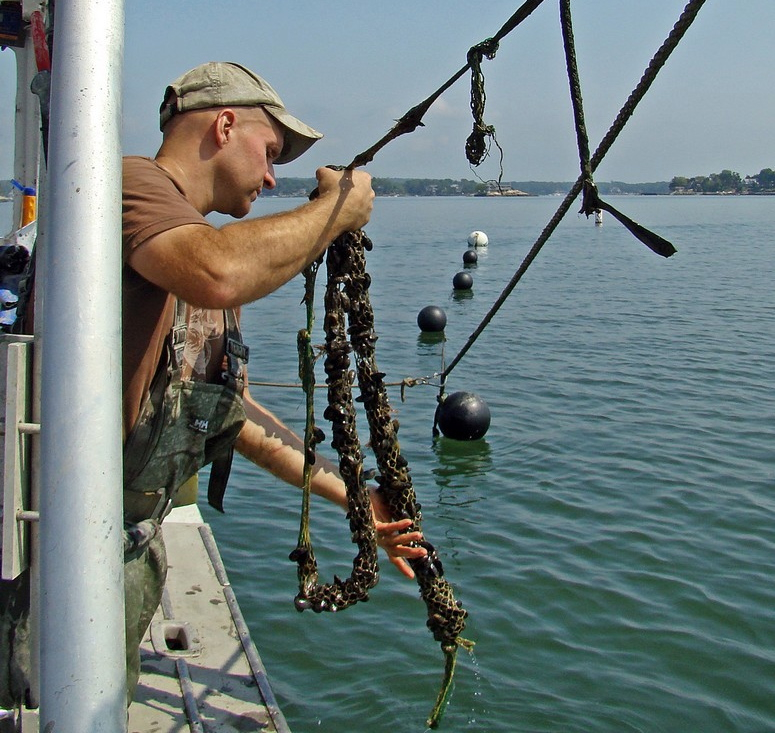
Ron GautreauAquaculture projects in Long Island Sound, like the one run by the author (pictured above), are growing seaweed, mussels, and scallops stacked above oysters and clams.
They’re back: Blue mussels and menhaden have returned to Long Island Sound this year in huge numbers. On this 40th anniversary of the Clean Water Act, many of us are celebrating their homecoming as a sign of the progress made reviving the sound. More needs to be done, but this welcome news of cleaner waters opens the opportunity to begin farming the urban sea.
Aquaculture has rightly earned a reputation for growing low-quality seafood at the expense of the environment, but a new form of ocean-friendly farming has emerged right outside of New York City. These small-scale vertical farms — some of the first in the country — are designed to grow multiple species of seaweed and shellfish, have small footprints, and provide an array of environmental benefits. Picture them as three-dimensional gardens, where seaweed, mussels, and scallops grow at the top of the water column, stacked above oysters and clams below. (Full disclosure: One of the authors of this article runs such a farm. There are also several others currently in
the permitting process.)
Eating local seaweed may seem exotic, but it’s coming to a plate near you. While shellfish have seen turns as both delicacies and a staple food source in our region for hundreds of years, the seaweed that grows alongside them is less familiar. It shouldn’t be, though: A native seaweed like Nori contains more vitamin C than orange juice, more calcium than milk, and more protein than soybeans. And it might surprise those of us on the hunt for omega-3s to learn that many fish do not create these heart-healthy nutrients — they consume them. By eating the plants fish eat, we get the same benefits. Already restaurants such as Beyond Sushi in Manhattan have crafted entire menus around these sea vegetables, and a bevy of gourmet chefs are working on recipes to make locavores swoon.
The best news is that these farms do more than grow food: In every sense, they restore rather than deplete. Matched up against land-based farming, these new ocean farms win every time. Seaweed and shellfish require no inputs — no land, no fertilizer, no fresh water — and since they grow three-dimensionally, they use space more efficiently than their land-based counterparts.
Shellfish and seaweed also act as filters, drawing out nitrogen and heavy metals — the primary objective of the Clean Water Act. While an important nutrient for humans, excess nitrogen from residential and agricultural runoff into the sound regularly triggers large-scale algae blooms that deplete oxygen levels, killing marine life and forcing beach closures. With a single oyster filtering up to 50 gallons of water a day, even small farms can have measurable impacts on water quality. Farms in waters polluted by heavy metals are cultivating shellfish and seaweed not for food production, but for the continued rehabilitation of the sound. One local initiative, spearheaded by the Bronx-based nonprofit Rocking the Boat and Charles Yarish of the University of Connecticut, grows kelp and mussels in the Bronx River to filter out mercury and other pollutants. Other local projects are even building oyster reefs to protect New York from storm surges and flooding.
Still not convinced? Local ocean farms are also emerging as a viable source for alternative energy. As the fastest-growing plant in the world, kelp is capable of producing over 2,000 gallons of biofuel per acre annually — five times more than the ethanol produced by corn and up to 30 times more per acre than soybeans. With companies like RPM Sustainable Technologies already working with Long Island Sound farmers to source kelp for their biofuel operations, the promise of growing alternative energy in local waters is on its way to becoming a reality.
Ocean farms open both new and old pathways for economic development. A decentralized system of small-scale operations could revitalize life along the shoreline, first by creating new green jobs on farms and in the biofuel industry and then, as the sea recovers, perhaps opening up old fisheries and bringing back traditional means of making a living. In April, the New Amsterdam Market staged a one-day outdoor fish market at the old Fulton Docks in lower Manhattan, demonstrating that the neighborhood has the potential to be home to local seafood, not just financial markets.
The urban sea promises to be one of New York’s great comeback stories. After 40 years of slow but steady progress under the Clean Water Act, it is time to deputize a new generation of ocean farmers to protect our sound and grow the green economy.




